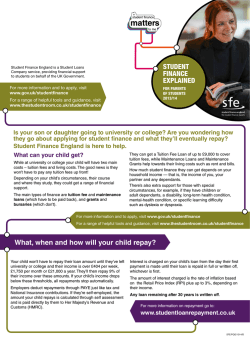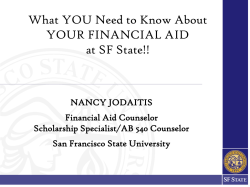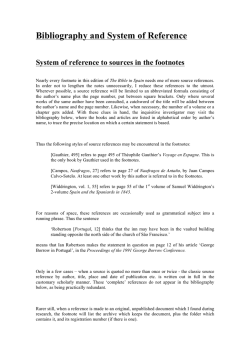
Paying for School - Allied Health Schools
3 This Getting Started Guide Paying for School 6 steps for success is your source for up-to-date information about choosing an allied health school or program. Use these tips to get organized and motivated—and get going on making your dreams a reality. AllAlliedHealthSchools.com Returning to school can help you achieve your dreams and investing in your education is a big move toward a brighter future. Your next step is figuring out how to pay for it. Here are 6 basic steps to take, and key questions to ask early on to help you make smart, confident decisions. Paying for School: 6 Steps for Success brought to you by AllAlliedHealthSchools.com 1 Keep this tip in mind at all times: borrow as little as possible Financial experts say every dollar you borrow will cost about two dollars by the time you repay the debt—ouch. Don’t be discouraged, though. With a little research, you can determine how much you really need to pay for school. Question #1 In a 2012 College Board survey, what percentage of students ruled out colleges on the basis of “sticker price” without considering financial aid? Paying for School: 6 Steps for Success A. 10 percent B. 25 percent C. 50 percent D. 60 percent brought to you by AllAlliedHealthSchools.com 2 1 are you eligible for federal aid? The U.S. government is the largest single source of higher education funding in America. To qualify for aid, you have to meet certain requirements, including: • Being a U.S. citizen or an eligible non-citizen. • Having a valid Social Security Number. • Having a high school diploma, or the equivalent such as a GED (General Education Development) certificate. NOTE: You can apply for financial aid before you get into school, but to receive any funds you have to be enrolled—in some cases at least part-time—and attending classes. 2 Question #2 What’s the average tuition at a 2-year college in the U.S.? Paying for School: 6 Steps for Success A. $6,542 B. $9,308 C. $11,138 D. $13,276 expenses beyond tuition • • • • • School fees Textbooks and other school supplies A laptop or computer Internet access Transportation or parking QUICK TIP: If you need to borrow from a private lender, consider a federal credit union or community bank. They often offer better interest rates and repayment terms than large corporate banks. brought to you by AllAlliedHealthSchools.com 3 3 do the schools you’re considering offer federal aid? Only schools that are accredited by organizations recognized by the U.S. Department of Education can offer federal financial aid. To get accredited, schools have to meet certain academic quality standards. Question #3 How many undergrads rely on some type of financial aid to pay for school? A. 22 percent B. 47 percent C. 66 percent D. 85 percent QUICK TIP: In certain cases your tuition may be tax-deductible. You can find more detailed information about education tax benefits at IRS.gov. QUICK TIP: The URL for the official FAFSA site is www.fafsa.ed.gov. Be careful to avoid websites that use FAFSA in the URL but end in .com, .biz, .net, etc. Many charge fees to fill out your FAFSA. If you want their advice, that’s your call, but you should not have to pay a dime to apply for financial aid. Paying for School: 6 Steps for Success brought to you by AllAlliedHealthSchools.com 4 4 pin down a “net price” estimate That’s all your costs minus grants and scholarships. If a school doesn’t include an easy-to-find, user-friendly net price calculator on its website, call the school’s financial aid office. 5 are grant, scholarship, workstudy opportunities available? A key advantage to these three types of financial aid: You do not have to repay them. • Grants are typically based on financial need and the cost of your program. Federal and state governments are the two largest sources of higher-education grant funding. • Scholarships are available from community groups, professional associations and more. Some are need-based and some are merit-based, and some may require you to maintain a certain grade point average. The harder you search, and the more you apply, the better off you’ll be. Millions of dollars in scholarship money goes unused each year. • Work-study programs pay students who work on or near campus while attending school. For more information, ask an admissions officer at the schools you’re considering. Paying for School: 6 Steps for Success Question #4 What’s the average annual tuition at a 4-year for-profit college in the U.S.? A. $10,540 B. $15.230 C. $20,986 D. $24,635 brought to you by AllAlliedHealthSchools.com 5 Question #5 What’s the average amount of financial aid undergrads receive for a year of school? 6 A. $5,700 B. $9,100 C. $11,925 D. $20,100 FIND A SCHOOL what federal loans are available? All loans have to be repaid with interest, so your No. 1. goal (yes, it bears repeating) should be to borrow as little as possible. You’re not required to borrow the entire amount offered to you. Your No. 2 goal should be to limit as much of your borrowing as possible to federal loans. Key advantages of federal loans: • Interest rates are fixed for the life of the loan. Private loans typically come with variable interest rates that often increase substantially, which can make them harder to repay. • In some cases, you can lower your monthly payments after making automatic electronic payments for a certain period of time. • Federal loans are eligible for income-based repayment plans and public service loan forgiveness. Some common federal loan programs: • Stafford Loan—Includes the Federal Family Education Loan (FFEL) and the Direct Loan programs • Parent PLUS Loan—Distributed to students’ parents through the FFEL and Direct Loan programs • Perkins Loan—For low-income students QUICK TIP: Some fields of study can help you qualify for generous loan forgiveness programs. For example, medical technicians may be eligible for partial loan repayment if they fulfill certain requirements after graduation. Check with your school’s enrollment advisor for specifics. Question #6 What’s the average amount of undergrad debt in the U.S.? Paying for School: 6 Steps for Success A. $14,700 B. $28,400 C. $58,600 D. $87,150 brought to you by AllAlliedHealthSchools.com 6 Know the financial aid lingo Here’s a quick list of terms you may encounter on your road to returning to school: Cost of attendance - Essentially the sticker price—all the expenses you’ll have to cover, including tuition, fees, housing, books and supplies, transportation and miscellaneous expenses. Dependent student – In the simplest terms, any student whose parents can still claim him or her as a dependent on their tax returns. In more specific terms, any student who is NOT one of the following: at least 24 years old, married, a graduate or professional student, a veteran, a member of the armed forces, an orphan, a ward of the court or someone with legal dependents other than a spouse. Expected Family Contribution (EFC) – The amount that you and/or your family will be expected to pay toward your education based on your FAFSA application. For the 2014-15 award year, families making $24,000 automatically qualify for an ETC of zero. That’s down from the previous income threshold of $32,000, which means many low-income students will qualify for more financial aid. Independent student – Any student who is at least 24 years old, married, a graduate or professional student, a veteran, a member of the armed forces, an orphan, a ward of the court or someone with legal dependents other than a spouse. National Student Loan Data System (NSLDS) – A federal student financial aid database where you can find out about the aid you’ve received. SAR (Student Aid Report) – Summary of your FAFSA information and what your family is expected to contribute toward your education. After you apply for aid, you’ll get your SAR in an email report within a day after your FAFSA is processed, or seven to 10 days if you mail in your application. Subsidized – A type of loan you don’t have to pay interest on while in school, during a grace period, or if a loan is deferred. Unsubsidized – A type of loan that starts accruing interest as soon as it’s disbursed. Financial experts say it’s smart to make payments on the interest while you’re in school, which will lower the amount you owe when you graduate. Sources: U.S. Department of Education; FinAid.org © 2015 All Star. All rights reserved. Quiz Answers 1: D. 60 percent 2: B. $9,308 3: D. 85 percent 4: B. $15,230 5: C. $11,925 6: B. $28,400 Sources: U.S. Department of Education; National Center for Education Statistics; The Project on Student Debt; The College Board and Art & Science Group, LLC; FinAid.org; fastweb.com; 2014 U.S. News & World Report Paying for School: 6 Steps for Success brought to you by AllAlliedHealthSchools.com 7
© Copyright 2024












